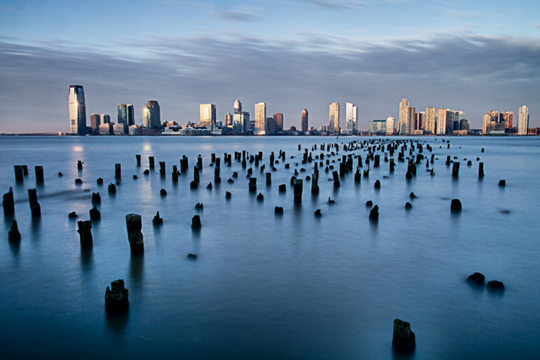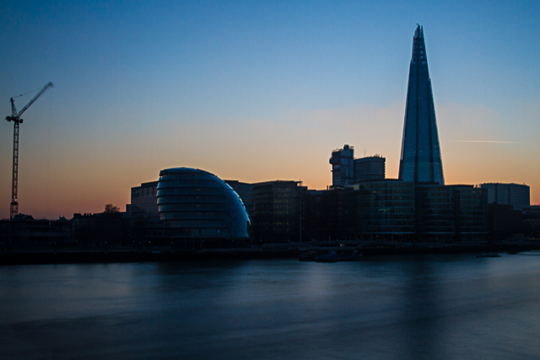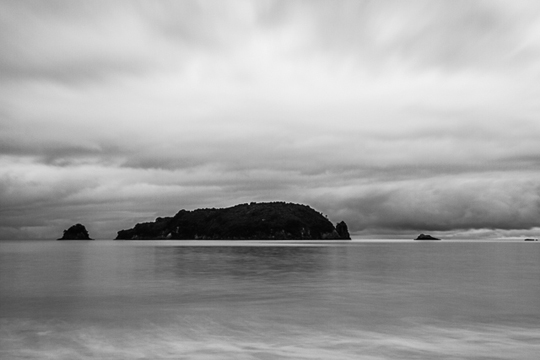
Jersey City Dawn (Canon 7D, 27mm, f/13, 30s, ISO 100)
Now that we’ve established in Part 1 why long-exposure photography is interesting and what it helps you achieve, I wanted to walk you through your first long-exposure shot, from location scouting all the way to post-processing.
Since you might not yet know if this is an area of photography you will really enjoy, I’ve designed this so your necessary investment beyond a good camera and a good lens is minimal (a few bucks).
Where to shoot
Since the most dramatic visual impact of long-exposure is on large bodies of water, it’s probably the best choice for a first shot. It’ll give you a sense of how different it can look, and a good notion of whether you like that look or not (some people, including but not limited to my wife, hate it).
In order to get the best “still water” effect possible, I would suggest picking a large body of water without excessive waves or ripples, and shooting wide-angle. Subjects may include:
- The ocean or the sea at high tide or low tide on a relatively quiet day,
- A lake on a day without excessive wind,
- A large river.
You can of course decide to pick a stream or another smaller body of water, but the impact of long-exposure on rushing water is truly bizarre, and unless you instantly fall in love with that liquid mercury look you’re less likely to enjoy the end results (or alternatively, you’ll be doing 1/8s exposures which will give you some really cool shots but barely count as long exposure…)
Generally, you can expect interesting light for about half an hour before sunrise and after sunset.
Having water in the shot is a prerequisite for what we’re trying to do here, but it’s nowhere near enough to get a satisfactory shot. In order to get an interesting shot, you need either an interesting foreground or an interesting background.
- Foregrounds may include: piers, rocks, boats (provided they’re absolutely still), pillars, piles, pebble beaches, etc.
- Backgrounds may include: buildings, skyscrapers, mountains, hills, volcanoes, etc.
See Jersey City Dawn (above) for an example of a photo with both interesting foreground (the piles) and interesting background (the skyscrapers). From a compositional point of view, if you do have both you need to make sure the foreground leads the eye to the background and doesn’t obstruct it. Since you’ll be shooting wide-angle, the foreground doesn’t need to be physically big (it will be big on the picture if it’s close to the lens) but the background does need to be big or it simply won’t have enough visual mass.
When to shoot
In order to avoid having to invest in expensive filters for a genre you’re not certain of liking, you should aim to shoot either at dawn or at dusk. If you’re shooting into the sun – East at dawn and West at dusk – you’ll want to shoot before the sun rises or after the sun sets: as soon as even a sliver of sun comes into your shot you won’t be able to shoot long exposures anymore.
Generally, you can expect interesting light for about half an hour before sunrise and after sunset.
Weather conditions will affect your shoot. Ideally, you should be looking for a nice day with a little bit of clouds. That way you get great colors, interesting light and an interesting sky.
A clear blue sky is the next best thing: not as exciting, but you get nice colors nonetheless. If the sky is grey and completely overcast, all may not be lost provided there’s structure in the clouds.
If it’s a bland and uniformly grey sky, then you’re probably better off heading off home. Keep in mind that despite weather forecasts, there’s an element of unpredictability to how gorgeous a sunrise or sunset may look. Once you’ve found your spot, you might have to go back several times to get the conditions you want for a great shoot.
I travel a lot for work, and I use a nifty little app on my phone called Photo Buddy which amongst other things gives me sunrise and sunset times based on my GPS location. There are many other sources for that information, but obviously you’re going to need it to decide when to show up.
How to shoot
I’ll assume here you haven’t invested in a tripod. If that’s the case, you need to build yourself a beanbag by stuffing chick peas or similar dried vegetables in a Ziploc bag. The bag should be big enough for you to set your camera and lens on it. The amount of stuffing should be sufficient for your camera to rest comfortably on it, but it shouldn’t be excessive: you need to be able to shape the bag to determine a stable angle for your lens.
When shooting with a beanbag, you can set it at ground level, in which case your camera will need to be right on the edge of the body of water (unless you want to include the ground as foreground, see Woods Hole Dawn in the previous article for an example of that).
If you find an elevated and relatively flat surface, you can also use that as a tripod of sorts by setting the beanbag on top of it. The Shard at Dusk was shot with a beanbag set on a lifebuoy fixed to the barriers alongside the Thames.

The Shard at Dusk (Canon 7D, 32mm, f/8, 25s, ISO 400)
Once you’ve set your camera on the beanbag and framed the shot, you need to set up the exposure. I’m going to assume you have a DSLR with exposure metering. I strongly recommend shooting RAW to maximize your ability to adjust things after the shoot. Set the camera to ISO 100 and to Aperture Priority mode at f/13. Focus about 2/3 into the picture (for optimal sharpness), and look at how long the camera says the exposure needs to be to have a properly exposed shot:
- If it’s less than 1s, then there’s too much light to do long exposure. Try closing the aperture some more, although it should be stressed that past f/22 (some say f/16) the picture quality starts to degrade a little due to Diffraction ().
- You should aim for at least 5s exposure time to see the long-exposure effects on the shot. You might have to wait a bit for the light to go down (if it’s dusk) or come back earlier the next day (if it’s dawn).
- If it’s more than 30s then you can’t shoot without a remote control (we’ll cover Bulb mode in the next installment). You should either open up the aperture below f/13 or increase the ISO above 100.
- With modern DSLRs, you can probably push the ISO to 400 without too much risk, but note that high ISO generates noise, and dark areas in a picture (which you will likely have since you’re shooting at dawn or dusk) are particularly prone to noise. At f/8 and ISO 400 you can still do interesting things, so don’t panic.
Once you have an exposure time between 5 and 30s, you’re good to go. Set your camera on timer, aim, and shoot. It’s absolutely vital that the camera does not move during the whole of the exposure, so be patient and wait for the shot to be well and truly done before touching and reviewing.
(Here’s a little tip I learned from using a beanbag: don’t use autofocus! Most lenses rotate when focusing, and if you use autofocus, since the lens is resting on your beanbag, it’ll move the camera and ruin your careful framing. Focus manually to avoid that issue.)
Do several shots just to be on the safe side. You can also vary exposures a little. I rarely if ever do HDR with long-exposure shots (I’ll explain why below), but bracketing might be interesting to get a variety of exposures and see which one in the end pleases you the most. You can also vary your compositions: remember, with a wide-angle lens any small variation in the foreground can lead to a very different shot indeed.

Grey Dawn on Hahei Beach (Canon 7D, 32mm, f/13, 15s, ISO 400, Edited with Kodak Tech Pan available in XEQUALS Black & White)
Post Processing
So you got up really early (or stayed up really late) but you’re keen to see the results. You head home and load your pictures in Lightroom (or some similar software). Here are a few tips specifically for post-processing the kind of shot you just took:
- Even though you’re shooting at dawn or dusk with lots of shadows, I wouldn’t recommend using High Dynamic Range (HDR) processing, essentially for two reasons.
- The first is that the water texture that you will get from shooting long-exposure is smooth and silky. HDR will bring some grit back into it by extracting every little bit of detail from the water. It kind of defeats the purpose.
- The second reason is that shadows are great, you should embrace them and make them part of the composition instead of trying to eliminate them.
- You can reinforce the smooth water effect if you wish to do so by using a local adjustment brush on the water and setting the clarity to -100. It’s often not necessary, but it can add just a little bit of that quiet, soothing feel that long-exposure water conveys.
- If your camera sensor isn’t perfectly clean, every speck of dust on there will show up on your shot, particularly if you increase Clarity. Be prepared to use all those nifty tools like Spot Removal and Adjustment Brush.
- If the colors are not particularly meaningful to your shot, consider black and white. This is especially true if you have strong graphical elements in the shot, lines, etc. This is also how you rescue a grey dawn picture provided you have texture in the clouds. See Grey Sunrise on Hahei Beach for an illustration of that. Note that even when you have glorious sunrise colors you may want to consider trying black & white. If the light is great, it works for monochrome too!
And there you have it, a cheap way of giving Long-Exposure photography a try.
In Part 3, we’ll be looking at more elaborate techniques like light-trails, ghosts, shooting rushing water and other things.


